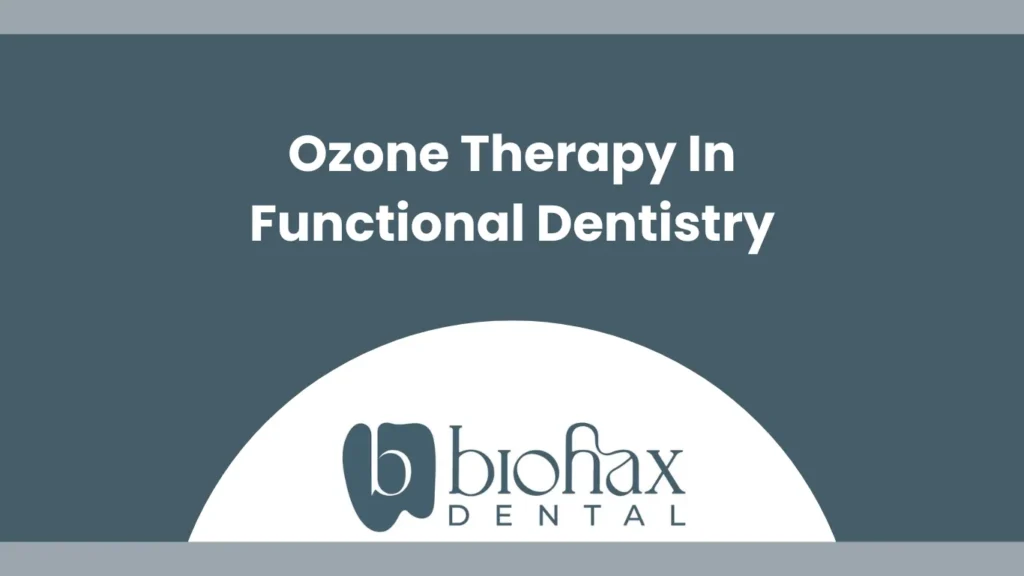

Ozone is a naturally occurring form of oxygen; its molecular structure is formed of three oxygen atoms instead of the regular two, and it exists mainly in earth’s upper atmosphere, protecting us from the harmful ultraviolet radiation. Apart from this vital UV-absorbing characteristic of ozone, it is among the most powerful oxidizing agents in nature, and it has potent antimicrobial activity, capable of eliminating nearly all harmful microorganisms. Furthermore, under controlled circumstances and in small doses, ozone is found to promote healing and increase blood flow, properties that allow it to be a useful candidate for multiple dental and medical applications. Let’s explore some of its uses in functional dentistry.
Ozone was used in healthcare as early as the 1850s to disinfect surfaces and surgical tools; since then, its applications expanded to include disinfecting public drinking water and, more recently, treating multiple dental and medical conditions. Ozone is used in its gaseous form or dissolved in water or oil; it can be applied directly on the lesions, injected locally, or systemically for various medical and dental conditions like arthritis, chronic low back pain, carpal tunnel syndrome, chronic non-healing ulcers, periodontal disease, caries, oral ulcers and ulcerating diseases like oral lichen planus, and pain management.
When administered in small doses and in a controlled manner, ozone has various beneficial effects on the human body; it has anti-inflammatory, analgesic, regenerative, and antimicrobial properties.
The combination of these effects of ozone is the basis for its use for wound healing, pain management, and treatment for various infective and inflammatory conditions.
Ozone was first used in dentistry in the 1930s by a German doctor called E.A. Fisch as a disinfectant and to aid with wound healing after dental surgeries. Today ozone is used for periodontal diseases, caries, osteonecrosis of the jawbone, and various oral ulcers.
Periodontitis is a severe bacterial infection of the gums that spreads to involve the jawbone and can result in loss of teeth. Due to its powerful antimicrobial and regenerative effects, ozone is useful not only in eradicating the infection but also in stimulating tissue healing.
The use of ozonated water or oil eliminates caries by stopping the bacterial activity inside the carious cavity and remineralizing them, restoring enamel integrity, and preventing tooth decay.
Ozone is frequently used in dentistry to sterilize cavities, root canals, pockets, surgical fields, and surgical equipment.
By potentially eliminating the risk of wound infection, stimulating healing and regeneration, and reducing pain, ozone plays an integral role in post-surgical care, and it was found to reduce complications when applied after tooth extraction.
Ozone is effective in treating aphthous ulcers, herpes labialis, and oral lichen planus, it promotes healing and eliminates the causative organism in the case of herpes labialis. It shows almost immediate results when used for aphthous ulcers, with some patients reporting healing within hours. In lichen planus, it was found to reduce symptoms and long-term outcomes.
Biofilms are adherent polymicrobial aggregates found on the surfaces of teeth; they contribute to plaque formation and can cause infections. Ozone penetrates these biofilms and eliminates bacteria, fungi, and viruses that can be found inside it, destroying these aggregates, which prevents plaque formation, teeth discoloration, infections, and tooth decay.
The proper use of ozone under strict controlled conditions by trained professionals has proven to be an effective, natural, minimally invasive, and safe choice for the management of multiple dental conditions. It is also a valuable preventive tool, which matches the holistic approach of functional dentistry and aligns with its goal to treat the root causes of dental problems, targeting overall health and well-being.
References
Srikanth A, Sathish M, Sri Harsha AV. Application of ozone in the treatment of periodontal disease. J Pharm Bioallied Sci. 2013 Jun;5(Suppl 1):S89-94. doi: 10.4103/0975-7406.113304. PMID: 23946585; PMCID: PMC3722714.
smile@biohaxdental.com
Fill out the form below and we will contact you during our working hours. If you have a dental emergency, please call (305) 603-8373.

We are a biological dentistry clinic with an integrated approach to treating oral problems by focusing on all aspects of health.
Monday: 9:00 am – 5:00 pm
Tuesday: 9:00 am – 5:00 pm
Wednesday: 9:00 am – 5:00 pm
Thursday: 9:00 am – 5:00 pm
Friday: 9:00 am – 5:00 pm
Saturday: Closed
Sunday: Closed
© Biohax Dental. All rights reserved. Website Designed By: Geek Dental Marketing.